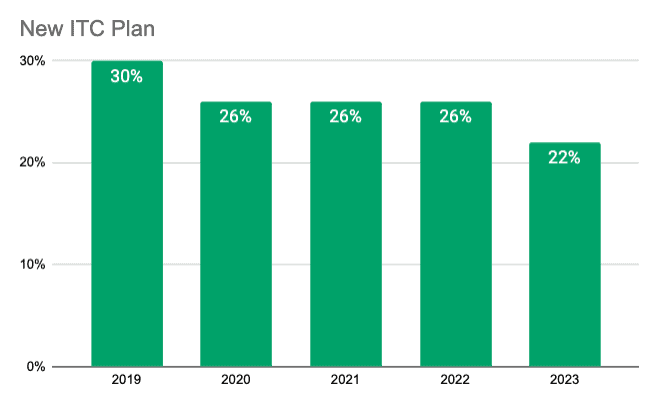If you live in California and are thinking about adding an energy storage system to your home or business, you’re in luck. The state is home to one of the few (and longest-running) energy storage incentive programs in the country.
Whether you’re looking for peace of mind, to lower your monthly utility bill, or something else, there are two primary storage incentives that can help make installing batteries more affordable: the Self-Generation Incentive Program (SGIP) and the Federal Solar Investment Tax Credit (ITC).
Let’s look at how these energy storage incentives work, who is eligible, and more.
California’s Self-Generation Incentive Program
 The California Self-Generation Incentive Program is recognized as one of the best incentives for solar storage. It offers financial incentives to support the installation of existing and emerging clean technologies, including energy storage, waste heat to power technologies, and microturbines. SGIP was created through Assembly Bill 970 in response to the state’s energy crisis back in 2001. Since then, the program has undergone many modifications and extensions, with the most recent change under Senate Bill 700 in 2018.
The California Self-Generation Incentive Program is recognized as one of the best incentives for solar storage. It offers financial incentives to support the installation of existing and emerging clean technologies, including energy storage, waste heat to power technologies, and microturbines. SGIP was created through Assembly Bill 970 in response to the state’s energy crisis back in 2001. Since then, the program has undergone many modifications and extensions, with the most recent change under Senate Bill 700 in 2018.
The California Public Utilities Commission (CPUC) officially administers the program, with a budget that has been expanded to $800 million through 2024 (bringing the grand total up to $1 billion in available funding). The bulk of this money is allocated to the newly created Equity and Equity Resiliency budgets, with about $60 million dedicated to general residential energy storage projects.
Who Is Eligible for SGIP?
SGIP is funded by and available to ratepayers of Pacific Gas & Electric (PGE), San Diego Gas & Electric (SDGE), Southern California Gas Company (SoCalGas), and Southern California Edison (SCE).
The program has three separate eligibility tiers (general market, equity, and equity resiliency), and each tier has its own eligibility requirements.
General Market Tier
The general market tier is based on storage system size and works on a graduated schedule, i.e. the rebate amount will depend on the size of the storage system and when the rebate is submitted. As the kilowatt-hour (kWh) capacity of the battery increases, so too does the rebate amount.
Currently, there are two remaining levels (Steps 6 and 7) for small-scale residential storage projects. Utilities at Step 6 are offering $200 per kWh of rebate funding per battery. When all four utilities move to Step 7, the general market tier rebate will drop to $150 per kWh.
Equity Tier
This category was created to help make energy storage solutions more affordable for low-income, indigenous, and underrepresented communities. Under this tier, eligible SGIP applicants qualify for an $850/kWh rebate.
For a $10,000, 10 kWh residential storage system, the equity rebate could cover as much as 85% of cost, bringing the new total closer to $1,500.
Equity Resiliency Tier
The equity resiliency category was designed for those who might be directly impacted by California’s worsening wildfires. More specifically, this tier is targeted towards homeowners who are classified as “medically vulnerable,” live in “fire danger zones,” or have experienced 2+ utility-scale Public Safety Power Shutoffs (PSPS). (Click here for more information.)
Eligible applicants for this tier qualify for up to $1,000/kWh in rebates. For a $10,000, 10 kWh storage system, it could cover the entire cost.
To see the most recent incentive rates offered by your local utility provider, visit SGIP’s official Program Metrics page.
How to Apply for California’s Self-Generation Incentive Program
SGIP is designed as a reimbursement, with homeowners and businesses required to cover the full cost of their energy storage systems upfront before applying for the program. Many installers help customers navigate the paperwork, and may even cover the upfront cost of these installations for their customers and recoup these expenses once the SGIP rebate goes through.
To get more details or double check the program status, check with your local utility, and talk with your installer.
The Federal Investment Tax Credit
If you’re installing solar and storage at the same time, you can take advantage of the Federal Investment Tax Credit (ITC).
Under the ITC, you can recoup 26% of the total cost of your clean energy investment (panels and storage included) through a deduction in your federal taxes (tax liability). This means that if your solar and storage system combined cost $20,000, you qualify for a $5,200 credit that you can use to pay off your next tax bill. Learn more about how to use the ITC for storage here.

The ITC has a step down schedule that was extended in late 2020. It keeps the residential system credit at 26% through 2022 before stepping down to 22% in 2023.
The bottom line? The ITC can be combined with SGIP to deliver some truly massive savings for anyone interested in going solar with storage.
Want to learn more? Check out our Beginner’s Guide to Solar Financial Incentives.
If you’re an installer, download The Pocket Guide to Selling Storage to get tips on how to add storage to your pitch.